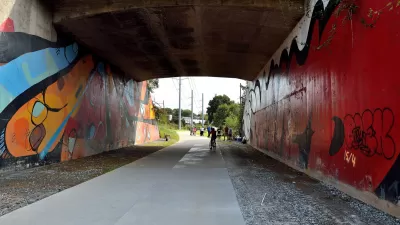A program to pay property-tax increases of nearby homeowners is welcome, but "about ten years too late," one advocate says.

Concerns about affordable housing, gentrification and displacement have accompanied the development of the Atlanta BeltLine since its earliest days. The vision for the project — a 22-mile multi-use trail built on an old railway line looping the entire city of Atlanta — was so clear a catalyst for rising real estate value that the original development plan, completed in 2005, included a goal of building 5,600 workforce housing units to mitigate the impacts of gentrification. Now, with more than half the time elapsed before the projected completion date of 2030, the BeltLine is still scrambling to make good on the promise of affordable housing. And some advocates say too much damage has already been done in terms of displacement, runaway home values, and speculative investment.
Late last year, the Atlanta BeltLine Partnership and Atlanta Beltline, Inc., launched a Legacy Resident Retention Program meant to help existing homeowners stay in their homes as property values, and taxes, continue to rise. The program is aimed at homeowners who have lived in and occupied their homes since at least 2017 and who earn less than 100% of area median income, which in Atlanta is $79,700 for a family of four. The program will cover the increased cost of property taxes for eligible homeowners through 2030. It’s open to people living in a handful of neighborhoods in south and west Atlanta where new BeltLine trails are expected to be completed in the next few years.
The groups running the program expect that some 2,500 homeowners are eligible in the targeted area, and that the program could cost $12.5 million over the next decade, says Rob Brawner, executive director of the Atlanta BeltLine Partnership, a nonprofit that helps guide the implementation of the BeltLine plan. So far, they’ve raised $500,000 from the electric utility Georgia Power, and $200,000 from Bank of America. To date, 128 homeowners have applied to the Legacy Resident Retention Program and 21 have been approved. It’s a small start, Brawner says, but the groups are looking for more funders, and being careful only to commit to those applicants that they know they can assist through the next ten years.
“We know that the long-term solution for this is not for philanthropy to indefinitely pay people’s property-tax increases,” Brawner says. “The long-term solution is a tax policy solution … That’s going to take some time, and we couldn’t afford to lose people [in the meantime].”
FULL STORY: The Atlanta BeltLine Wants to Prevent Displacement of Longtime Residents. Is it Too Late?

Study: Maui’s Plan to Convert Vacation Rentals to Long-Term Housing Could Cause Nearly $1 Billion Economic Loss
The plan would reduce visitor accommodation by 25,% resulting in 1,900 jobs lost.

North Texas Transit Leaders Tout Benefits of TOD for Growing Region
At a summit focused on transit-oriented development, policymakers discussed how North Texas’ expanded light rail system can serve as a tool for economic growth.

Why Should We Subsidize Public Transportation?
Many public transit agencies face financial stress due to rising costs, declining fare revenue, and declining subsidies. Transit advocates must provide a strong business case for increasing public transit funding.

How to Make US Trains Faster
Changes to boarding platforms and a switch to electric trains could improve U.S. passenger rail service without the added cost of high-speed rail.

Columbia’s Revitalized ‘Loop’ Is a Hub for Local Entrepreneurs
A focus on small businesses is helping a commercial corridor in Columbia, Missouri thrive.

Invasive Insect Threatens Minnesota’s Ash Forests
The Emerald Ash Borer is a rapidly spreading invasive pest threatening Minnesota’s ash trees, and homeowners are encouraged to plant diverse replacement species, avoid moving ash firewood, and monitor for signs of infestation.
Urban Design for Planners 1: Software Tools
This six-course series explores essential urban design concepts using open source software and equips planners with the tools they need to participate fully in the urban design process.
Planning for Universal Design
Learn the tools for implementing Universal Design in planning regulations.
Ascent Environmental
Borough of Carlisle
Institute for Housing and Urban Development Studies (IHS)
City of Grandview
Harvard GSD Executive Education
Toledo-Lucas County Plan Commissions
Salt Lake City
NYU Wagner Graduate School of Public Service





























